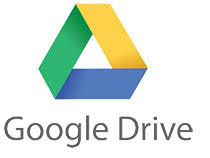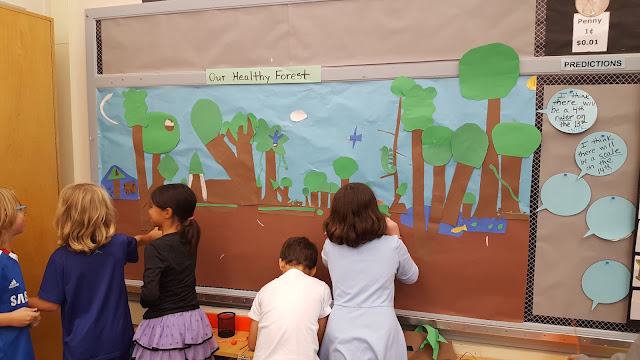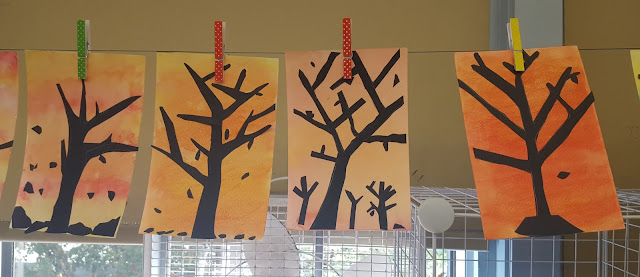Greetings 3rd Grade Families!
I hope you are all enjoying this wonderful fall weather!
LITERACY
Last week we read the story “Alexander, Who Used to be Rich Last Sunday”. It was a story about a boy who squandered away his money, after embarking on a series of foolish choices. The students did a great job on their selection test for this story which measures vocabulary and reading comprehension. Success on these selection tests is just the first step. The next step is to begin the practice of writing short essays to demonstrate an understanding of what we read.
Writing evidence-based reading responses is a skill we will practice and develop all year. Using this week's story, we practiced our first reading response of the year, as we answered the question above.
We once again used the "web" graphic organizer to help us organize our information before we began writing.
The students were also introduced to the idea of using "evidence from the text" to support our thinking. Using and locating evidence from the text is a big focus in 3rd grade. As a result, students will always be encouraged to use their book during all post-reading tests or written responses.
After finding the first few examples together, the students were asked to finish filling out the web on their own.
Once our webs were complete, we did a collaborative write of our first reading response essay of the year.
During our collaborative write, we paid special attention to our topic sentence, our transitions, our sentence fluency, our word choice, and our conclusion sentence.
When we were all finished, each student had an example of what a well-written reading response should look like.
This will provide an anchor for their future written responses.
Now that we had a finished paragraph of writing, it was time to move to the next step - publish your written response on the computer.
Students had several opportunities to begin the process of typing their writing on their Google Drive at school this week. From my computer, I can then view all documents the students type up in their 3rd grade folder they have already shared with me.
 This will be an on-going opportunity and expectation throughout the year.
This will be an on-going opportunity and expectation throughout the year.
WRITING
Most students have finished their informational paragraphs about their summer, had one-on-one writing conferences with me, and are ready to publish neatly, and on the computer.
The students are proving to be quite savvy on the computer, and some students have finished typing up both of their Summer paragraph and their Alexander Reading Response. I am very proud of the hard work the students are putting in during Writer's Workshop.
MATH
This week we nearly completed our Unit 1 concepts as we explored line plots and reviewed our subtraction fact strategies.
 We explored a line plot this week as we conducted yet another survey relating to the number of people who live "Under the Same Roof".
We explored a line plot this week as we conducted yet another survey relating to the number of people who live "Under the Same Roof".
SUBTRACTION FACTS
Students were given a fluency test on subtraction facts. This showed that many students still need to work on mastering their facts.
As a result, we spent a couple of days reviewing our subtraction facts as we color-coded the various strategies on a subtraction table.
Students will be given some opportunities to practice their facts in class, but I strongly encourage this to become an area of home practice for students who are still working towards mastery. The results of this first subtraction check-up will come home tomorrow. Please take note of your child's progress and need for practice when they bring home their results tomorrow.
This week we will wrap up our Unit 1 concepts and the students will be given an assessment on graphing this Friday.
SCIENCE
This week we explored the question “What does a healthy forest look like?” The students seemed very interested and some had great prior knowledge to contribute.
We previewed some vocabulary that related to forests, but more specifically to a reading we did that described healthy forests.

The students did a great job coming up with their own synonyms and antonyms!
In order to build some vocabulary skills and practice using a dictionary, I paired students up and assigned each partnership a vocabulary word.
On Friday, we used our art time to create a collaborative mural of a healthy forest. Each student pulled a word from a bucket. The word represented a necessary part of our healthy forest. They were then responsible for contributing that part to our display.
The students did a fantastic job monitoring the forest’s creation, pointing out what parts were still missing or what parts we needed more of. They were enthusiastic and responsible as they assembled the parts themselves, glued them to the display, and made choices as to where to embellish the display with extra detail. It truly felt like a collaborative, positive learning experience. Tomorrow we will decide if everything we need made it into the display, and then we will add labels.
Next up, we will explore the question "what happens to the forest when a tree is cut down?" as we look at the cause and effect relationships that result.
ART
We made some finishing touches on our Fall Tree Silhouettes, and they are now hanging on bulletin board outside the classroom.
Feel free to stop by and take a peak.
IMPORTANT DATES
September 27 - Photo Day
October 14 - NO SCHOOL – Teacher In-service
October 18 - Field Trip to Hoyt Arboretum




































































































